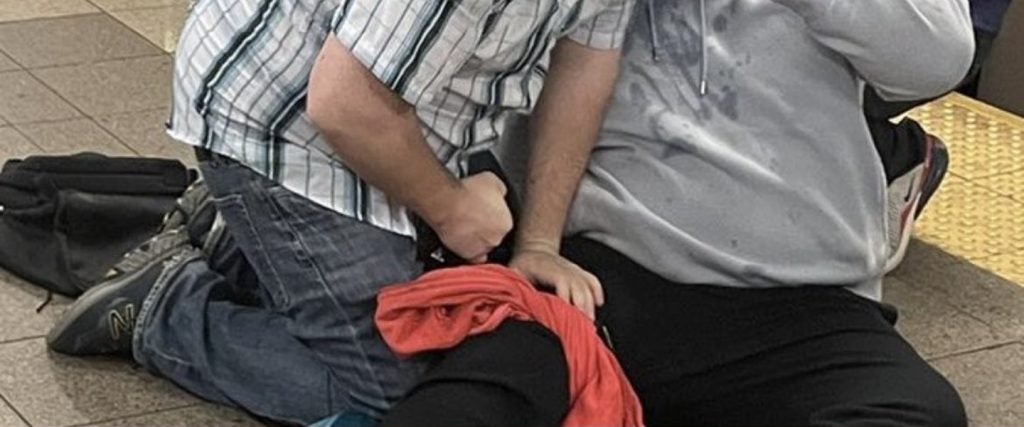In the aftermath of the Tuesday morning shooting in a Brooklyn subway that left at least 23 people injured, one man, standing amid pooling blood and injured bodies on the subway station floor, saw an opportunity to potentially save a life.
In an image that went viral this week, we see the unnamed man in plaid kneeling next to an injured man. He’s tightening what appears to be a belt around the thigh of the hurt man, basically improvising a tourniquet, or a small band wrapped tight around a limb or extremity in order to stop blood loss from an open wound.
It was a melancholy, if heroic, reflection of the world we live in today: A mass shooting can happen seemingly anywhere in public, and odds are, an outburst of indiscriminate violence will leave multiple people in need of immediate trauma treatment. In this context, few things are more convenient and crucial than a tourniquet — especially if you have a professional “CAT,” or “combat application tourniquet,” handy in the pocket of a tote bag or backpack.
It’s unclear when the tourniquet was first invented, but there’s evidence that warriors used some version of a tightened strap to stem bleeding as far back as the fourth century B.C., when Alexander the Great’s forces were conquering the Persian Empire. Some centuries later, Roman soldiers were known to don tourniquets made of strips of bronze and leather — beautiful and robust, if extremely painful.
There are multiple kinds of tourniquets available today, but the mechanics of its use remain mostly unchanged. A good combat tourniquet is an easy-to-carry tool that can be applied quickly to yourself or another body; it consists of a loop with a band, a clip and a “windlass,” which is a small rod used to torque the band tight. You slip the bleeding limb through the loop, tighten the band, twist the windlass until it hurts so bad that you think you’re going to cut through the flesh, and then close the strap to lock in the windlass.
Medical experts note that using a tourniquet isn’t the first or even best option for certain kinds of gunshot injuries. Persistent bleeding from the torso, neck and head area can’t be addressed with a tourniquet; also, you should first attempt to stop limb bleeds by applying strong, persistent pressure using your hands and any kind of bandage (a ripped shirt, sock, etc.).
If that doesn’t work, a tourniquet, applied two or three inches above a wound on the limb, is the next best play. Do note that it can backfire and worsen the trauma if the tourniquet isn’t applied tightly enough (experts say that it should really hurt when applied correctly). The person putting on the tourniquet needs to observe that the bleeding slows and stops at the wound as they tighten; there should be no discernable pulse when you check an artery near the wrist or ankle of the secured limb.
Bleeding out is one of the most common ways to die when you’re shot, whether it’s in war or civilian life; unsurprisingly, gunshot victims are five times more likely to need blood transfusions in order to survive. A proper tourniquet can grant someone a head start on this fight, which is especially critical considering an arterial bleed can kill you in three minutes flat. And despite the heroism of the man in the Brooklyn subway, experts warn that newbies should resist the urge to improvise a tourniquet from a belt or shirt if they don’t really know what they’re doing.
In other words, carrying a quality combat application tourniquet, and perhaps signing up for your friendly neighborhood “Stop the Bleed” training, could make all the difference in a swiftly unfolding life-or-death scenario. It is, indeed, tragic that we live in a nation that cannot honestly grapple with its epidemics of male violence or dangerous gun ownership, instead leaving the populace to try and pick up the pieces ourselves.
But such is the nature of true community defense — and even if there was a “Good Guy with a Gun” around, odds are that someone will end up hurt, helpless and losing time. At this point, what’s clear is that more policing won’t save us from lone-wolf violence. Neither will a surveillance state that’s always two steps behind.
A tourniquet, on the other hand? That just might do it.

